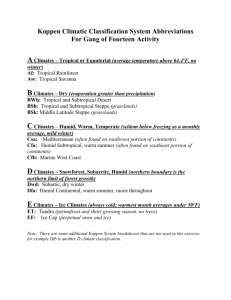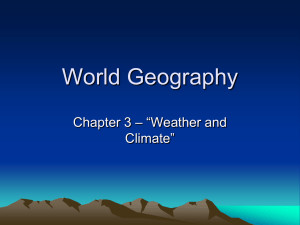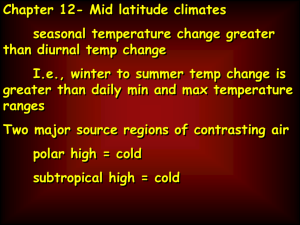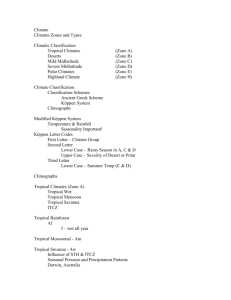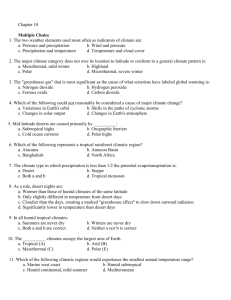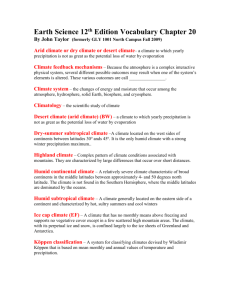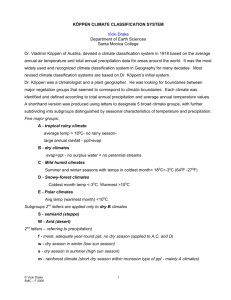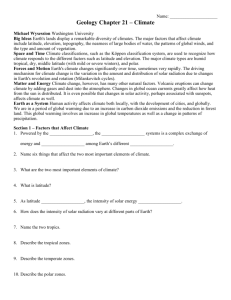PowerPoint Presentation - regional climates
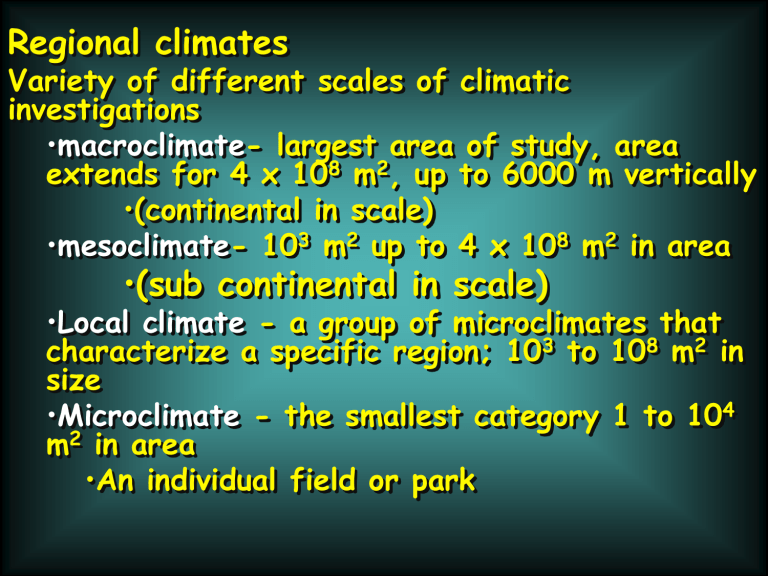
Regional climates
Variety of different scales of climatic investigations
•macroclimate - largest area of study, area extends for 4 x 10 8 m 2 , up to 6000 m vertically
•(continental in scale)
•mesoclimate - 10 3 m 2 up to 4 x 10 8 m 2 in area
•(sub continental in scale)
•Local climate - a group of microclimates that characterize a specific region; 10 3 to 10 8 m 2 in size
•Microclimate - the smallest category 1 to 10 4 m 2 in area
•An individual field or park
Schematic of climatic scales of study
Climate classification: What, Why and How?
What:Organize regions with similar climates
Why:Understand what causes the climate to be what it is and when to worry about departures
How:Look at moisture, temperature, evaporation, transpiration, vegetation, altitude, latitude, etc. and decide on some value that sets the boundary (threshold)commonly related to plants
Köppen climate classification scheme
Uses Monthly mean temps, monthly mean precipitation, and annual mean temps to establish major climatic zones
•designated with capital letters
Widely used but frequently criticized
•no agreement between plants and climate
•variability in the factors that set boundary
= climate classification changes constantly
Class
A
B
C
Köppen Climate table
Class name
Tropical humid
Dry
Subcategory Subcategory name
Af
Am
Aw
BWh
BSh
BWk
BSk
Mild Mid-Latitude Csa
Csb
Cfa
Cwa
Cfb
Cfc
Key characteristic for sub categorization
Tropical wet No dry season
Short dry season; heavy monsoonal rains in other months Tropical monsoonal
Tropical savanna Winter dry season
Subtropical desert Low-latitude desert
Subtropical steppe Low-latitude dry
Mid-latitude desert Mid-latitude desert
Mid-latitude steppe Mid-latitude dry
Mediterranean
Mediterranean
Humid subtropical
Humid subtropical
Marine west coast
Marine west coast summer
Mild with no dry season, hot summer
Mild with dry winter, hot summer
Mild with no dry season, warm summer
Mild with no dry season, cool summer
D
E
H
Severe
Mid-Latitude Dfa
Polar
Highland
Dfb
Dwa
Dwb
Dfc
Dfd
Dwc
Dwd
ET
EF
Humid continental
Humid continental
Humid continental
Humid continental
Subarctic
Subarctic
Subarctic
Subarctic
Tundra
Ice Cap
Humid with severe winter, no dry season, hot summer
Humid with severe winter, no dry season, warm summer
Humid with severe, dry winter, hot summer
Humid with severe, dry winter, warm summer
Severe winter, no dry season, cool summer
Severe, very cold winter, no dry season, cool summer
Severe, dry winter, cool summer
Severe, very cold and dry winter, cool summer
Polar tundra, no true summer
Perennial ice
Climate zones of the world
Divided into alphabetic categories
A, B, C, D, E, H zones
KÖPPEN Climate classification
Tropical climates designated with a capital “A”
Based in part on vegetation zones that are sensitive to moisture and temperature
Tropical (A) Climates -
All tropical climates are warm the subdivisions are based on differences in rain
Tropical Rainforest (Af) Climates located
0-15° N/S Lat.
Diurnal temperature range is greater than the difference between the warmest and coolest months
(annual range).
Every month has precipitation and no month is deficient in rainfall. This high amount of rainfall keeps the soil moisture at capacity. EVT occurs at potential rate
Am- Tropical monsoonal climate
Diurnal temperature range is greater than the difference between the warmest and coolest months (annual range). seasonal precipitation surplus and deficit
Distinctive dry and wet season related to wind reversal
Aw- Tropical savanna climate
Diurnal temperature range is greater than the difference between the warmest and coolest months (annual range). precipitation deficit much of the year
Distinctive dry and wet season
B climates - semi-arid to arid
Several sub categories
All B-climates have less than 30” of annual precipitation
BW climates are arid (less than 10”) and can be divided further based on latitude
(temperature)
BWh- low latitude hot and dry
BWk- mid latitude cool and dry
BWh is a function of Hadley cell circulation; occur between 18 and 32° N-S Latitude
BS climates are semi-arid (more than 10” but less than 30” of rain) and can be divided further based on latitude (temps)
BSh- low latitude hot and dry
BSk- mid latitude cool and dry
A gradational change from A climates on either side of the B climates
C climates- Mesothermal temperate
C-subcategories
Cf = moisture evenly distributed throughout the year
Cw = 10x the amount of moisture in the summer as compared to the driest winter month
Cs = 3x as much moisture in the winter as compared to the driest summer month; at least 1 month with less than 3 cm of precipitation
Csa= called Mediterranean climate
•western edge of mid-latitude continents
Cfa= called a Humid subtropical climate
•Southeastern edge of mid latitude continents
Cfb= called Marine west coast
•Western edge of continents at higher latitudes
D climates- Severe Mid-latitude
All have severe winters; short summers that range form hot in the south to cool to the north
E climates - Polar No true summer
Cold all year long
Köppen climate regions of
North America
Köppen climate regions of the US
Trewartha climate classification scheme - a modified version of the Köppen system.
Attempts to redefine the broad climatic groups in such a way as to be closer to vegetational zoning.
Group A - this is the tropical climate group, defined as places which do not receive annual winter frosts (in maritime regions this corresponds closely to the Köppen boundary).
Climates with no more than 2 dry months are classified Ar , while others are classified Aw . There is no specific monsoon climate identifier.
Group B - this is identical to the Köppen scheme.
Group C - in the Trewartha scheme this category includes subtropical climates only (8 or more months above 10 °C).
The identifiers are the same as the first two letters of the
Köppen identifier - the Mediterranean climate is denoted Cs and the humid subtropical climate, Cf or Cw .
Trewartha Climate scheme (Continued)
Group D - this group represents temperate climates.
Continental climates are represented as Dca (Köppen Dfa, Dwa,
Dsa ) and Dcb (Köppen Dfb ,Dwb ,Dsb ). Maritime temperate climates (Köppen Cfb ,Cwb ,Csb ,Cfc ) are denoted Do in the
Trewartha classification. The dividing point between maritime and continental climates is 0 °C in the coldest month, rather than the usual Köppen value of -3 °C.
Group E - this group is undivided and contains the continental subarctic climates (Köppen Dfc ,Dwc ,Dfd )
Group F - this is the polar climate group, split into Ft (Köppen
ET ) and Fi (Köppen EF ).
Group H - Highland climates - in which altitude is the most important factor determining climate.
Other climate classification schemes
Thornthwaite -based his scheme on moisture effectiveness and temperature efficiency
•mathematical relationships easy to identify from available meteorological data
•Also uses info on season when rain or snow falls
Genetic classification
Identifies the “Why” of climates first and uses that information to establish each climatic zone
-which air mass dominates
Air masses and climatic types
Warm
Wet
Tropical wet mid latitude wet
Polar wet
Tropical wet and dry
Tropical dry
(desert)
Mid latitude summer or winter dry
Polar wet and dry mid latitude dry
(desert)
Polar dry
(desert)
Cold
Dry
Grp
I
Grp
II
Grp
III
Climate zones determined by air mass
Vegetation
Closely linked to climate
Often used as PROXY data for lack of climate data
5 distinct veggie zones
•Forests = trees; many different types of
•e.g., hardwood, conifer, rainforest
•Deserts = discontinuous veggies; scrub brush; cactus, etc.
•Grasslands = grasses
•Taiga = cold; climate evergreen conifer forests lichens
= cold; grasses sedges mosses and
